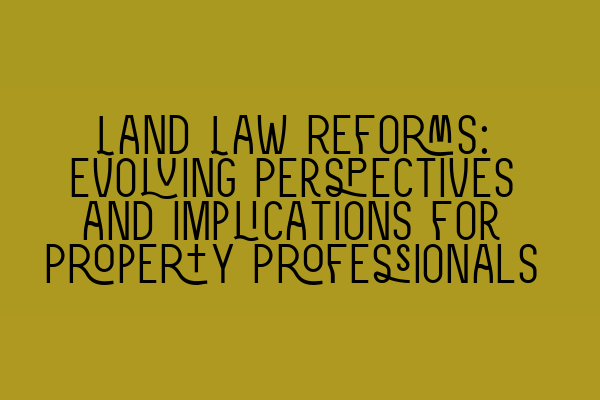Land Law Reforms: Evolving Perspectives and Implications for Property Professionals
Land law is a complex and ever-evolving area of legal practice that plays a crucial role in ensuring the fair and efficient functioning of property markets. Over the years, there have been several key reforms and changes in land law that have shaped the perspectives and practices of property professionals, including solicitors, conveyancers, and real estate agents. In this blog post, we will explore some of the most significant land law reforms, their implications for property professionals, and how these changes have transformed the landscape of property law.
1. The Land Registration Act 2002: Streamlining Property Transactions
One of the landmark reforms in land law was the introduction of the Land Registration Act 2002. This legislation brought about a significant shift in the way property transactions are conducted in England and Wales. The Act introduced a system of compulsory registration of title, which replaced the earlier system of deeds and documents.
The Land Registration Act 2002 has brought several benefits for property professionals. Firstly, it has made property transactions more transparent and efficient by providing a centralized register of land and property ownership. This has reduced the risk of fraud and improved the overall accuracy of land records. Additionally, the Act has streamlined the conveyancing process, making it easier for property professionals to handle transactions and provide accurate advice to their clients.
For more information on the Land Registration Act 2002 and its implications, you can refer to our related article: SQE Contract Law: Analyzing Landmark Cases and Influential Judicial Decisions.
2. The Leasehold Reform Act 1967: Empowering Tenants
The Leasehold Reform Act 1967 was a significant milestone in land law as it aimed to address the power imbalance between landlords and tenants. The Act introduced various provisions to empower residential leaseholders and provide them with greater security and control over their homes.
One of the key provisions of the Leasehold Reform Act 1967 is the right to lease extension. This allows residential leaseholders to extend their leases by a significant period, providing them with greater stability and long-term value. The Act also introduced the right of first refusal, which gives residential leaseholders the opportunity to purchase the freehold of their building if the landlord decides to sell.
These reforms have had a profound impact on property professionals who deal with leasehold properties. They have had to familiarize themselves with the intricacies of the Leasehold Reform Act 1967 and advise their clients accordingly. Property professionals need to be well-versed in the rights and obligations of both landlords and tenants to provide comprehensive and accurate advice.
To dive deeper into the Leasehold Reform Act 1967 and its implications, you can refer to our related article: Understanding Contractual Capacity: Rights and Limitations.
3. The Landlord and Tenant Act 1954: Balancing Landlord and Tenant Rights
The Landlord and Tenant Act 1954 represents a fundamental piece of legislation that governs commercial leases in England and Wales. The Act provides a framework for the rights and obligations of both landlords and tenants, offering them a degree of security and stability in their business relationships.
Under the Landlord and Tenant Act 1954, tenants of commercial properties have the right to seek lease renewal at the end of their term, subject to certain conditions. This gives tenants the reassurance that they can continue their business operations without the fear of eviction or unreasonable rent increases.
For property professionals dealing with commercial leases, understanding the intricacies of the Landlord and Tenant Act 1954 is essential. They need to advise their clients on their rights and obligations under the Act and guide them through lease renewal negotiations or potential disputes.
For a comprehensive understanding of the Landlord and Tenant Act 1954, you can refer to our related article: Interactive SQE Mock Tests for Contract Law: Test Your Knowledge.
4. The Growth and Infrastructure Act 2013: Streamlining Development
The Growth and Infrastructure Act 2013 brought about significant reforms in land law with the aim of streamlining the planning and development process. One of the key provisions of the Act is the introduction of a new planning permission regime called “automatic planning permission” or “permitted development rights.”
Permitted development rights allow certain types of development to proceed without the need for a full planning application. This has simplified and expedited the development process, enabling property professionals to bring projects to fruition more efficiently. However, it is important to note that permitted development rights come with certain limitations and conditions to ensure that the development is in line with planning regulations.
Property professionals need to be well-versed in the provisions of the Growth and Infrastructure Act 2013 to advise their clients on the feasibility and implications of permitted development rights. They need to ensure that any proposed development meets the necessary criteria and complies with all relevant laws and regulations.
If you want to deepen your knowledge of the Growth and Infrastructure Act 2013, you can refer to our related article: Join Our SQE Contract Law Webinars: Expert Insights and Guidance.
Conclusion
Land law reforms have had a profound impact on property professionals, shaping their perspectives and practices in the ever-evolving field of property law. The Land Registration Act 2002, the Leasehold Reform Act 1967, the Landlord and Tenant Act 1954, and the Growth and Infrastructure Act 2013 represent just a few of the key legislative changes that have transformed the landscape of land law.
As property professionals, it is crucial to stay updated with the latest reforms and understand their implications for your clients. By keeping abreast of changing legislation and understanding the evolving perspectives in land law, you can provide valuable and informed advice to your clients, ensuring their property transactions are conducted smoothly and efficiently.
For more comprehensive knowledge and preparation for the SQE property law and land law exams, you can explore our related article: SQE Prep: Mastering the Essentials of Contract Law.
